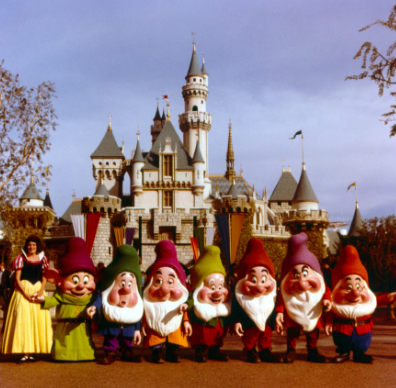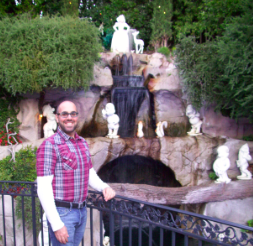The Disneyland Resort is the “Merriest Place on Earth” during the holiday season as guests clamor to experience the all new Christmas experiences on Buena Vista Street and in Cars Land at Disney California Adventure. Many guests will no doubt journey to Walt Disney’s Original Magic Kingdom, Disneyland, to enjoy classic attractions and favorite holiday traditions. We at The Walt Disney Family Museum would like to highlight some of the must see Disneyland attractions guests can still experience today that tie directly back to Walt Disney himself.
So with no further ado we present:
Disneyland - The Quintessential Classics
The Must See Attractions that made Walt Disney's Magic Kingdom
Internationally known as "The Happiest Place on Earth"!
In honor of The Walt Disney Family Museum’s special exhibition, Snow White and the Seven Dwarfs: The Creation of a Classic, our tour continues with yet another detour, The Fairest Detour of All into Fantasyland to visit: Snow White’s Adventures and Snow White Grotto.
 As we enter Fantasyland during this Thanksgiving holiday season, we should pause to think of the many things that we are truly thankful for. Personally, I am thankful for the creation of “Snow White and the Seven Dwarfs”, as it paved the way for Walt Disney’s cornucopia of successes. The profits from Snow White allowed Walt to finance the construction of the Walt Disney Studios in Burbank, where countless Disney classics were created and a Magic Kingdom was born. At the time of its production, “Snow White and the Seven Dwarfs was dubbed by critics as “Disney’s Folly”, a term that would be resurrected by the press 17 years later during the construction of Walt’s second folly, Disneyland. Thankfully, Walt’s critics were wrong in both cases, and “Snow White and the Seven Dwarfs” has been a treasured feature at Disneyland since opening day.
As we enter Fantasyland during this Thanksgiving holiday season, we should pause to think of the many things that we are truly thankful for. Personally, I am thankful for the creation of “Snow White and the Seven Dwarfs”, as it paved the way for Walt Disney’s cornucopia of successes. The profits from Snow White allowed Walt to finance the construction of the Walt Disney Studios in Burbank, where countless Disney classics were created and a Magic Kingdom was born. At the time of its production, “Snow White and the Seven Dwarfs was dubbed by critics as “Disney’s Folly”, a term that would be resurrected by the press 17 years later during the construction of Walt’s second folly, Disneyland. Thankfully, Walt’s critics were wrong in both cases, and “Snow White and the Seven Dwarfs” has been a treasured feature at Disneyland since opening day.
Snow White made her first appearance at Disneyland during the opening day telecast, “Dateline Disneyland”, which was televised live to a national audience on the ABC television network on July 17, 1955. Snow White had the honor of representing Fantasyland in Disneyland’s inaugural parade, riding down Main Street USA under a flower strewn canopy atop a beautiful throne on her float surrounded by the Seven Dwarfs. Her namesake attraction in Fantasyland, “Snow White’s Adventure” would open that same day.
Walt Disney’s original team of Imagineers was made up of a hand picked group of Disney Animators, like Ken Anderson who worked as Art Director in 1937 for the film “Snow White and the Seven Dwarf’ and then led the design team on the “Snow White’s Adventure” attraction. The original Snow White Dark Ride in Fantasyland was designed so that guests felt like they were the main character of the story; in this case, Snow White. Few guests understood this concept, and wondered why Snow White was not featured in the ride. During the 1983 renovation of Fantasyland, all of the Fantasyland dark rides were redesigned and enhanced to include the main characters of the films they represented. Today, Disneyland Guests riding “Snow White’s Scary Adventure” encounter the fair princess as she watches the Seven Dwarfs performing “The Silly Song”.
Continuing down a small path to the right of Sleeping Beauty Castle, we come across an intimate grotto on the shores of the castle moat dedicated to Snow White. Opened on April 9, 1961, Snow White Grotto features a wishing well as well as a beautiful waterfall with white marble statues of Snow White and the Seven Dwarfs. According to legend, crates from Italy containing the marble statues arrived anonymously one day at the Disney Studios. Walt selected Imagineer John Hench to come up with a solution on how to display the statues in Disneyland. John recalled,
“We encountered a special challenge when Walt unexpectedly received a gift of statues of Snow White and the Seven Dwarfs carved from pure-white Carrara marble, which arrived in wooden crates from Italy with no return address or any other indication of who might have made and sent them. Walt called me down to the studio warehouse to look at them, and told me he wanted me to put them somewhere in Disneyland. I had to tell him that we would have a perspective problem with the figures: the sculptor had carved Snow White the same size as the dwarfs. “Just figure it out,” said Walt. My next thought was that the white marble statues could make any place I chose to put them look like a graveyard. “It could look like the place where we buried the dwarfs,” I told Walt. “For God’s sake, Johnny,” he replied, “don’t make it look like a cemetery.” He had no sympathy for me.”
The anonymous sculptor had based the look and proportions of the statues on a set of licensed Snow White and the Seven Dwarfs soaps. All of the figures in the soap set were roughly the same size meaning that Snow White was as tall (or as short!) as the Dwarfs. John Hench’s solution to this scale problem was the use of forced perspective. The statues were placed in a vertical arrangement with Snow White at the top of the grotto, which was highest and farthest from the guest. Because of the height and distance, the guest’s eye would naturally expect the Snow White statue to be small. He also had an under-scaled deer sculpted to stand next to Snow White, helping to validate her human size. In addition, John Hench devised a clever and unusual waterfall to be a part of the scene. With a normal waterfall, the water tapers in, narrowing as it goes down. However in the Grotto, the waterfall begins at Snow White’s feet and grows wider as it falls, enhancing the illusion of height. The statues of the Seven Dwarfs were placed closer to the wide bottom of the waterfall reinforcing the illusion that the Dwarfs were smaller than Snow White.
Walt Disney was pleased when John Hench presented his drawings for the Grotto, but was immediately concerned that children might get into the water. “You know, People are going to see that water”, Walt told John, “and they’ll want to throw money in the pool – then we’ll have kids getting into the water. Why don’t you make a wishing well, put a catch tray in for the coins and a protective grate, so that the kids won’t be tempted to jump into it.” Walt decided that the money collected from the well would be donated to Variety Clubs International, “who will use the money for their charitable work among the needy.” John Hench designed the Snow White Grotto Wishing Well after the well in the film where Snow White sings the song “I’m Wishing” and first encounters the prince. Today as guests enter the Grotto and walk up to the well, they can hear Snow White’s echo eternally singing “I’m Wishing.”
On the October 27, 1954 premier of the “Disneyland” television program, Walt Disney famously stated, “I only hope that we never lose sight of one thing - that it was all started by a mouse.” Some might argue that it actually all started with a rabbit (Oswald the Lucky Rabbit), or a little girl (Alice in Cartoonland), but no one disputes the fact that Snow White and the Seven Dwarfs is truly “The One That Started It All”. Today, Disneyland guests who visit Snow White’s Scary Adventure and Snow White Grotto continue to be delighted by the beloved characters from Walt Disney’s First Full Length Animated Feature.
Next time we’ll continue our tour by heading over to the Rivers of America in Frontierland to explore the Mark Twain Riverboat and the Golden Horseshoe Saloon… That is unless the Holiday Season leads us off our itinerary to discover yet another Disneyland Quintessential Classic!

Joseph Titizian (pictured on the left at Disneyland's Snow White Grotto, November 2012) is an inaugural member of The Walt Disney Family Museum volunteer team. He is a regular contributor to this blog, and has developed continued education courses for the volunteer team. A lifelong Disney fan, Joseph has previously worked at Disneyland Park and Pixar Animation Studios.
